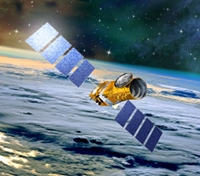Summary
 |
|
The CoRoT spacecraft. Credit: CNES/ D. Ducros |
In addition, CoRoT will also be used to detect subtle brightness changes caused by sound waves that resonate through the star. These create a 'starquake' that sends ripples across the star's surface, altering its brightness. The exact nature of the ripples allows astronomers to calculate the star's precise mass, age and chemical composition. The technique is known as asteroseismology and ESA's Solar and Heliospheric Observatory (SOHO) has been taking similar observations of the Sun for years. So, the CoRoT data is essential to compare the Sun with other stars.
Instead of being an isolated national mission, ESA's involvement places CoRoT into the European framework to search for habitable planets.
About CoRoT
CoRoT is a mission led by the French National Space Agency, CNES. It is a 27-cm aperture space telescope designed to detect tiny changes in brightness from nearby stars. The spacecraft was launched on 27 December 2006 from the Baikonur Cosmodrome in Kazakhstan, Russia.
ESA has joined the mission by providing the optics and baffle for the telescope and testing of the payload. Through this collaboration a number of European scientists, from Denmark, Switzerland, the United Kingdom and Portugal, have been selected as Co-Investigators in open competition. As a result of ESA's participation in CoRoT, scientists from ESA's Member States also have access to the satellite's data.
ESA's Research and Scientific Support Department (RSSD) at ESTEC is a full partner in CoRoT by providing the on-board Data Processing Units (DPU's).
The ESA PRODEX programme has supported the development of the CoRoT telescope baffle, and the software development and data processing of CoRoT light curves.
The ground stations used for CoRoT are located in Kiruna (S), Aussaguel (F) Hartebeesthoek (South Africa), and Kourou (French Guyana), with mission-specific ground stations in Alcantara (Brazil) and Vienna (A).
